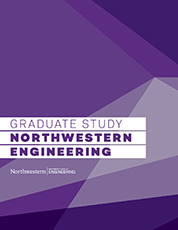EDI Alumni Network Helps Students Find Internships and Jobs
Chris Spaulding will start at Milwaukee Tool after an internship

During the summer term, most students from the Segal Design Institute's Master of Science in Engineering Design Innovation (EDI) program participate in internships around the world.
Internships play an important part in an EDI student's journey to become T-shaped students—individuals with deep expertise in one area along with broad knowledge of human-centered design—who can create a career about which they are passionate. Along the way, students receive support from EDI's Director, Jim Wicks, and EDI's Studio Director, Amy O'Keefe, especially in the form of connections to a broad network of EDI alumni.
Four EDI ‘19 students—Chris Spaulding, Alyssa Brown, Joanne Ting-yu Hsu, and Sara Gnolek—completed internships this past summer at companies or organizations where an EDI alumnus also works, including Milwaukee Tool, Kaiser Permanente Design Consultancy, Feeding America, and Dish Network.
Indeed, EDI has more than 170 alumni and they play an active role in helping students prepare for their careers. Alumni make connections for internships, host company visits, or visit Northwestern's Evanston campus to give studio talks about how design integrates into diverse fields.
Spaulding spent his summer as a Concept Engineering Intern at Milwaukee Tool. While he is not able to disclose what the focus of his internship was, he could share that “it was an awesome project that really challenged me both from an engineering and human-centered design aspect.”
He felt fortunate to have two EDI alumni, Julia Savich (EDI ‘17) and Ellen Owens (EDI ‘18), working at Milwaukee Tool during his internship.
“Julia took me on a research trip to show me how they go about design research at Milwaukee Tool and was also available for any questions I had,” said Spaulding. “Ellen was in my same engineering group and she was a great mentor for me. Anytime I had questions, needed feedback on an idea, or help with prototyping, Ellen was always there.”
When Savich joined the Concept Department at Milwaukee Tool after graduation, she was the first EDI alumnus at the company. Her team has since recognized that the skills she brought from EDI aligned “extremely well” with the company's own design process.
“My EDI background allows me to lead user research and contribute to high-level engineering discussions through uncovering more technically-focused user needs,” said Savich.
The following year, Milwaukee Tool hired Owens. Savich believes that the company now sees EDI graduates as ready to share its vision for innovation.
“EDI and Milwaukee Tool share a common thread with a passion for the users and fostering a root cause and continuous improvement mindset,” she explained. “EDI students aren't satisfied with making a single solution to a problem. They want to uncover the underlying user needs and find the best solution or set of solutions to that problem.”
Spaulding found similarities between the workplace culture of Milwaukee Tool and EDI during his internship.
“The culture there reminds me a lot of the culture we have in the EDI program,” said Spaulding. “Everyone is always helping each other out even if they're on a completely different project, from brainstorming to prototyping, it's all about teamwork and building upon one another to discover and create the next product for our end users.”
Spaulding felt well-prepared for his internship by the EDI program.
“EDI really set me up for success in the internship in so many ways,” he said.
In his first week at Milwaukee Tool, Spaulding was given a project to work on throughout the 12-week internship and charged with creating a functioning high-fidelity prototype by the end.
“I started as we would with any project in EDI, which was to establish a project plan and schedule,” he explained. “From there, it was just following the design process, or the famous double diamond, where I began by exploring user needs and observing behavior in this specific user area, translating all of the research into insights through synthesis to scope down further for ideation and low fidelity prototyping. After the low-fidelity prototypes were done, we analyzed them in reference to the user requirements and determined as a team which direction I should go in for the final high fidelity prototype. In the end, I was able to present the user journey and story with a product demonstration to the concept management team and the marketing team which was a success.”
The connections that Spaulding made with EDI alumni at Milwaukee Tool have continued to be valuable now that he is back on campus and finishing up the program. Months after his internship finished, Spaulding still receives updates from Owens about the status of several prototypes that he helped develop.
“It's awesome to see the work I was a part of moving on in the process to where it might be a product seen on shelves someday. It makes me very excited to see where the work is at when I return to Milwaukee Tool in January 2020 as a full-time Concept Engineer.”

